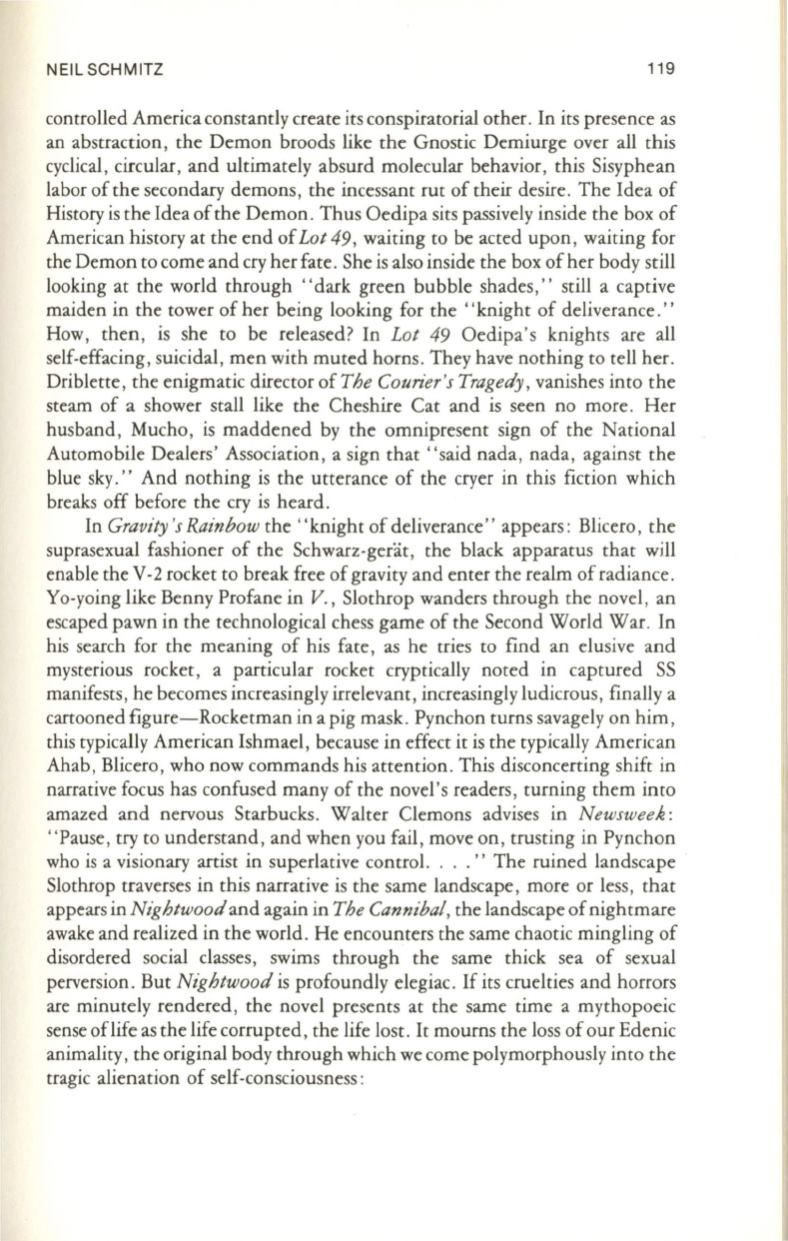
NEILSCHMITZ
119
controlled America constantly create its conspiratorial other. In its presence as
an abstraction, the Demon broods like the Gnostic Demiurge over all this
cyclical, circular, and ultimately absurd molecular behavior, this Sisyphean
labor of the secondary demons, the incessant rut of their desire. The Idea of
History is the Idea ofthe Demon. Thus Oedipa sits passively inside the box of
American history at the end of
Lot
49, waiting to be acted upon, waiting for
the Demon to come and cry her fate . She is also inside the box of her body still
looking at the world through "dark green bubble shades," still a captive
maiden in the tower of her being looking for the "knight of deliverance ."
How, then, is she to
be
released? In
Lot
49 Oedipa's knights are all
self-effacing, suicidal, men with muted horns. They have nothing to tell her.
Driblette, the enigmatic director of
The Courier 's Tragedy,
vanishes into the
steam of a shower stall like the Cheshire Cat and is seen no more. Her
husband, Mucho, is maddened by the omnipresent sign of the National
Automobile Dealers' Association, a sign that "said nada, nada, against the
blue sky." And nothing is the utterance of the cryer in this fiction which
breaks off before the cry is heard .
In
Gravity's Rainbow
the "knight of deliverance" appears: Biicero, the
suprasexual fashioner of the Schwarz-gerat, the black apparatus that wjll
enable the V-2 rocket to break free of gravity and enter the realm of radiance.
Yo-yoing like Benny Profane in
V.,
Slothrop wanders through the novel , an
escaped pawn in the technological chess game of the Second World War. In
his search for the meaning of his fate, as he tries to find an elusive and
mysterious rocket, a particular rocket cryptically noted in captured SS
manifests, he becomes increasingly irrelevant, increasingly ludicrous, finally a
canooned figure-Rocketman in a pig mask. Pynchon turns savagely on him,
this typically American Ishmael, because in effect it is the typically American
Ahab, Blicero, who now commands his attention. This disconcerting shift in
narrative focus has confused many of the novel's readers, turning them into
amazed and nervous Starbucks . Walter Clemons advises in
Newsweek:
"Pause , try to understand, and when you fail, move on , trusting in Pynchon
who is a visionary artist in superlative control. ... " The ruined landscape
Slothrop traverses in this narrative is the same landscape, more or less , that
appears in
Nightwood
and again in
The Cannibal,
the landscape of nightmare
awake and realized in the world . He encounters the same chaotic mingling of
disordered social classes, swims through the same thick sea of sexual
perversion. But
Nightwood
is profoundly elegiac. If its cruelties and horrors
are minutely rendered, the novel presents at the same
time
a mythopoeic
sense oflife as the life corrupted, the life lost.
It
mourns the loss of our Edenic
animality, the original body through which we come polymorphously into the
tragic alienation of self-consciousness :


